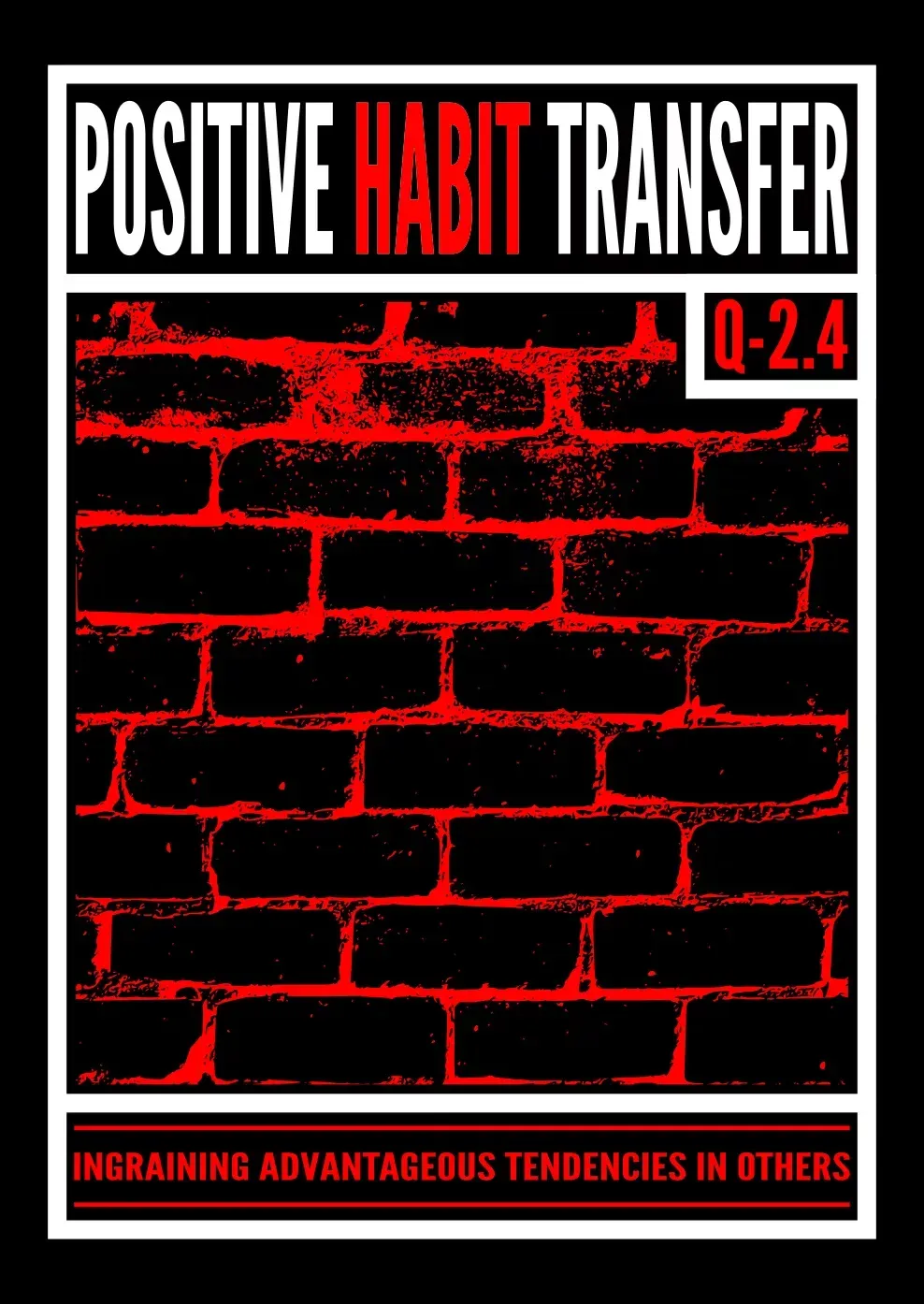POSITIVE HABIT TRANSFER (Q2.4)
Ingraining Advantageous Tendencies In Others
A man cannot give away what he himself does not possess
A Habit is a regular tendency that is hard to give up. By regular, we mean periodic, in the sense that it is something done (or refrained from) at a measurable interval. A tendency, the something done, is a type of behavior or characteristic that has become so ingrained over time that a person engages in it without active thought, like lighting up a cigarette every time he starts the car.
A Habit, standing alone, can be positive, negative or neutral.
- A negative Habit is one that is damaging to the individual who engages in it, the people who might be affected by it or both. Texting while driving is an example of a negative Habit. It is a regular tendency that threatens the safety of the driver, his passengers and the motoring public with whom he shares the public roadway.
- A neutral Habit is one that is neither damaging nor Advantageous to the individual or anyone else. Chewing gum while driving is a neutral Habit. Although it might relax the driver, it does not create a superior circumstance through Movement. Most of what we call nervous Habits are neutral Habits. It is just repetitive behavior that has no significant effect on anyone. At their worst, they are a waste of time.
- A positive Habit, a Brick, is a regular tendency that is Advantageous to the individual or others. Wearing a seat belt is a positive Habit. It reduces the likelihood of serious injury in the event of collision, which is Advantageous to both the driver and his Concentrica.
Through IMPACT, the HIM helps other men discontinue their negative Habits, minimize time spent on neutral Habits while initiating and ingraining positive Habits.
IMPACT is an acronym formed by the different aspects of what HIM does to achieve strong effect through forcible contact:
Influence: igniting a powerful desire for Movement
Missionality: Serving in the High Impact Zone
Positive Habit Transfer: ingraining Advantageous tendencies in others
Accountability: submitting to Standard through Enforcement and Consequence
Correction: zealously advocating for shared virtue
Targeting: initiating Missionality in others
Bad Habits are easy to slip into, but hard to break. Positive Habits are hard to develop, but easy to slip out of. If it were otherwise, people would simply replace their bad Habits with good ones without the help of anyone else. But it doesn’t work that way. Most people need forcible contact from another person in order to replace their negative Habits with positive ones. This help is best delivered in the form of the Positive Habit Transfer (PHT) .
PHT starts with Influence. Through word and deed, the HIM Persuasively models his own positive Habits to ignite a desire for change in others. This presupposes that the HIM actually engages in the positive Habits he is trying to model as it is axiomatic that no man can give away what he himself does not possess. It would be like trying to start a fire with a cold ember.
Likewise, the HIM knows that he is mostly likely to have strong effect when he is working within his High Impact Zone. Having learned his D2X over time, he focuses his energy on his Daffodil–the people-group he was born to Serve. That doesn’t mean that he cannot pass positive Habits on to people outside of his Daffodil, just that he will have much stronger effect if he stays Missional.
Because positive Habits are easy to slip out of, the HIM must also take measures to ensure that his own Guardrails are not crumbling while he is trying to help others build theirs. The pursuit of proper personal alignment that is at the heart of the Get Right is not a static undertaking. Having gotten Right, a HIM remains susceptible to backsliding into misalignment with himself, his Concentrica and his Creator if he is not vigilant in his efforts to continue to Accelerate. A major component of this effort is Accountability, the submission to Standard through Enforcement and Consequence. Without Accountability, a HIM will not be able to keep his own Bricks in place long enough to pass them on to anyone else.
For a HIM to pass positive Habits he must be able to discern them from those that are negative or neutral. In other words, he must have a firm grasp on what he believes is Advantageous as opposed to what is not for both an individual and a Group. Goo Nation has difficulty doing this because its goal is universal Happiness rather than Group Advantage. To obtain Group Advantage, one must be able to separate individual tendencies that are Virtuous from those that are not. Then, one must be willing to advocate for Virtue. This is what F3 calls Correction, and it is centered on the HIM’s willingness to talk his own walk rather than succumb to cultural pressure not to judge, as that (coupled with hypocrisy) is the the high and mortal sin of Goo Nation.
Finally, to truly ingrain a positive Habit in others, the HIM must Target them by initiating Missionality into their lives. Having a Mission with an Articulated Purpose gives a person a reason to change for the better. Teaching them that they must Get Right in order to Live Right helps them see why their regular tendencies matter. If they are going to pass positive Habits they must first develop them.
A man cannot give away what he himself does not possess.
Guardrails allow a man to Accelerate without crashing
Through PHT, the HIM helps others eliminate negative Habits, become less distracted by neutral Habits and strengthen positive Habits. Bricks are the positive Habits that are joined into the Routines that form a person’s Guardrails, which are the foundational precepts that protect and incentivize Acceleration to Advantage.
To better understand the purpose of Guardrails, picture those television commercials that depict a sports car whipping through the German countryside. The driver is always driving by himself in the dead center of those narrow twisting lanes. You think, man I would like to drive like that (which is the point of the commercial), but then you see this disclaimer scroll across the bottom of the screen: professional driver on a closed course–do not attempt.
That’s a good warning, because most of us do not spend our lives driving on a closed course populated by professional drivers. The roads we drive on contain all sorts of known and unknown hazards–many arising from the Amateur drivers with whom we share the road. Unlike those professional drivers in the commercial, no matter how Prepared we are, we can’t drive in the center of the lane and we have to take measures to avoid being forced into the ditch.
The problem is not that the road is too narrow. The minimum width of an American highway lane is 12 feet, with a 10 foot shoulder on the outer edge. Since most cars are only about 7 feet wide, that means that we have about three times as much space as we need–if we always stay in our lane. But we can’t. Which is why at dangerous points along the highway strong guardrails are placed to reduce the risk of serious accidents. Unlike professional drivers on closed courses who are driving to drive, we are doing the best we can to get somewhere fast with all the attendant distractions that come with the open road. We need those guardrails.
The life of a HIM is like that open road driven by Amateurs. Although we drive it as best we can as Pros, we are constantly distracted by our Jesters, Obstacles and the emotions of Amateurs that threaten to force us into the ditch if we ourselves are not Prepared. Yet we can’t be too careful, because that would slow us down to a crawl and keep us from Accelerating. Which is why a HIM constructs Guardrails in his life (just like we have on the highway), except that instead of being made of wood, concrete or steel, personal Guardrails are constructed from positive Habits.
Through Positive Habit Transfer we stand on the shoulders of giants
To illustrate the PHT, let’s start with how my flight instructor taught me the takeoff. I had rolled out to the airport for my first flying lesson at about nine that morning. It was a hot summer day. Twenty minutes later I was sitting in the pilot’s seat at the end of the runway with my sweaty hands on the yoke, looking down the shimmering runway.
On the way over from the hangar, my instructor had taught me how to steer the plane by controlling the rudder with my feet. Once cleared for takeoff, I had haltingly maneuvered the airplane to takeoff position with the nose pointing into the wind. I figured we would sit there for a few minutes while he explained some things. Nope.
“What the hell are you doing?” He asked.
“I don’t know.” I answered. “I’ve never flown before. I thought I told you that.”
“Well look. You can’t just sit here. When the tower clears you, you have to take off. Look,” he said, pointing to a line of airplanes waiting behind us to get on the runway. “You’re holding up traffic son.”
“Yeah, but –-,” and then he pulled out the throttle and we lurched forward. As we began picking up speed I realized that he didn’t have his feet on the rudder, so I had to steer the plane. Which I did, badly.
“Straighten it out,” he advised. “You can’t take off sideways.” He seemed oddly calm for a guy in an airplane piloted by a man who had never flown before. When we got to the right speed, he told me to pull gently back on the yoke and just like that, we were in the air. I had learned to takeoff in about 45 seconds, an aspect of flying for which I had allotted about ten hours in my mind. As we flew over my car in the parking lot, I realized that I had left it there only twenty-five minutes earlier, and here I was flying already. Take out the takeoff time (and walking to the plane), and you were left with the twenty minutes my instructor had used to teach me the preflight inspection. Unlike the casual way he had taught me to takeoff, he had been very deliberate about the preflight. His emphasis seemed backwards to me, but what did I know? I just did what he told me to do, at least at first.
Every time we flew, my instructor made me execute the preflight precisely as he had taught it to me the first day. On a laminated card in the airplane was a checklist that had to be performed in the exact order listed. While I loved to fly, performing the preflight was my least favorite part of every lesson. I just couldn’t wait to get up and punch holes in the sky and each moment I spent on the ground kept me from that.
One morning I decided to save a little time on the preflight by only eye-balling the leading edge of the elevators instead of actually running my hand along them as the checklist prescribed. My instructor watched me do that without comment, so I assumed that he approved of my practical shortcut. With most Tasks I had learned up to that point in my life, I had done them by the book to start with and then found more expedient methods with practice and repetition. I assumed that the preflight was no different.
When I was done, the instructor and I both climbed into the aircraft, as we always did. But when I reached over to start the engine, I found the key missing. I looked at my instructor, who just looked back at me. “Where’s the key?” I asked.
“In my pocket.”
“How am I going to fly this plane if you don’t give it to me?” I asked.
“You’re not.” He said. “At least not until you preflight this plane.”
“I did.”
“You did? Did you do every step the way it says on the card?” He asked.'
“Yes . . . well, not exactly.” I admitted, remembering that I had not actually run my hand along the elevator looking for obstructions or cracks.
“Well?” He asked, clearly intent on making a point. So, without arguing, I got out of the aircraft, walked back to the empennage and ran my hand along the elevators like I was supposed to do. When I had climbed back (mildly exasperated) in the pilot’s seat the key was still missing from the ignition and the expression on my instructor’s face had not changed.
“What?” I asked. “Didn’t you see me do it? C’mon, let’s fly.” I said.
“Sure. As soon as you preflight this airplane. That means every step, in the order set out on the checklist.” I realized then that he wanted me to redo the entire preflight because I had half-performed one stupid step. I also realized that we weren’t budging until I did it.
So I got back out on the hot tarmac and did the whole darn thing again. Each step, with exaggerated deliberateness. By the time I finally finished and climbed back aboard, with my shirt drenched with sweat and stuck to my back and chest, I was pretty huffy. The instructor slapped the key into my outstretched palm, but he grabbed my wrist before I could insert it into the ignition and asked, “what are you so mad about?”
“C’mon,” I said. “What’s the point of making me do the whole thing over again just because I skipped half a step? What’s the point? You could have just told me not to skip any steps without trying to teach me some kind of lesson.”
“I’m not trying to teach you a lesson about the preflight. I’ve already done that. Whether you do it right now is up to you. What I’m trying to teach you about is respect.” He said evenly.
“Respect?” I asked, surprised. “For you? I respect you.”
“No, it has nothing to do with me. It’s respect for the dead I’m talking about.”
“What dead?” I asked, perplexed.
“The men who died for each item on that preflight checklist. We didn’t just make that list up out of thin air. It’s a list of mistakes made by the men who died from making them. It exists so you won’t make the same mistakes yourself and die yourself, along with every poor soul stupid enough to get on an airplane with you. You can call it crap, but the least you can do is spend two minutes doing correctly what another man died not doing because he didn’t know about it.”
Now that I saw his point, I had to laugh. The guy had a way of searing important stuff into my brain, despite my cocksure unwillingness to listen.
“Where did you learn to teach this way?” I asked him.
“From my flight instructor smart ass. Where do you think? It’s called Positive Habit Transfer. He transferred positive habits to me, and now I’ve transferred them to you.”
By nature I am not a careful man. My instructor (through his years of experience) recognized that trait in me and made sure to use a method of instruction that transferred the positive Habit of preflight to me in a way that would stick. He was a HIM.
A HIM will gain Influence through the exercise of his own positive Habits. But to Live Right he must transfer those Habits to younger men through the PHT so that they in turn can help others build their Guardrails.
None of us alone is a great man. We all stand on the shoulders of giants.
UPDATED: May 21, 2025

Additional Study Materials
Socratic
Can you learn to do things right from a man who does things wrong?
What is the purpose of building positive Habits?
What is the purpose in passing positive Habits on to others?
Spur
A man cannot give away what he himself does not possess
Guardrails allow a man to Accelerate without crashing
Through Positive Habit Transfer we stand on the shoulders of giants
Podcasts
2020
2019
Additional Resources


Facebook
Instagram
X
LinkedIn